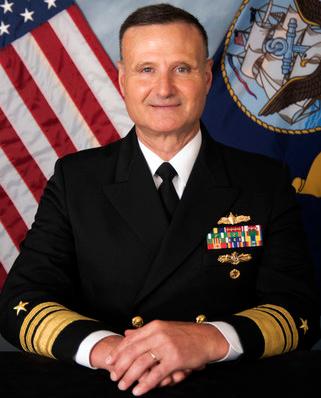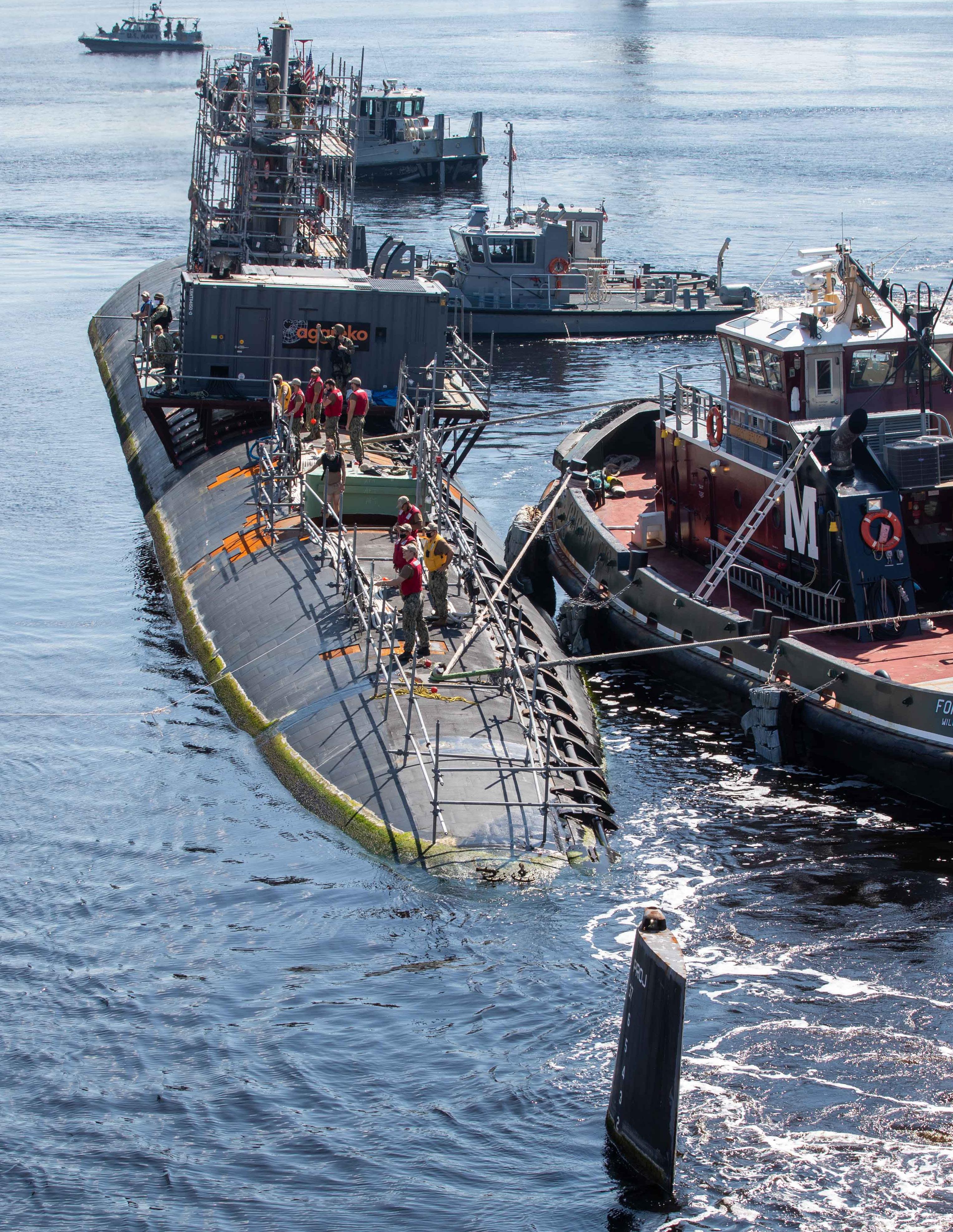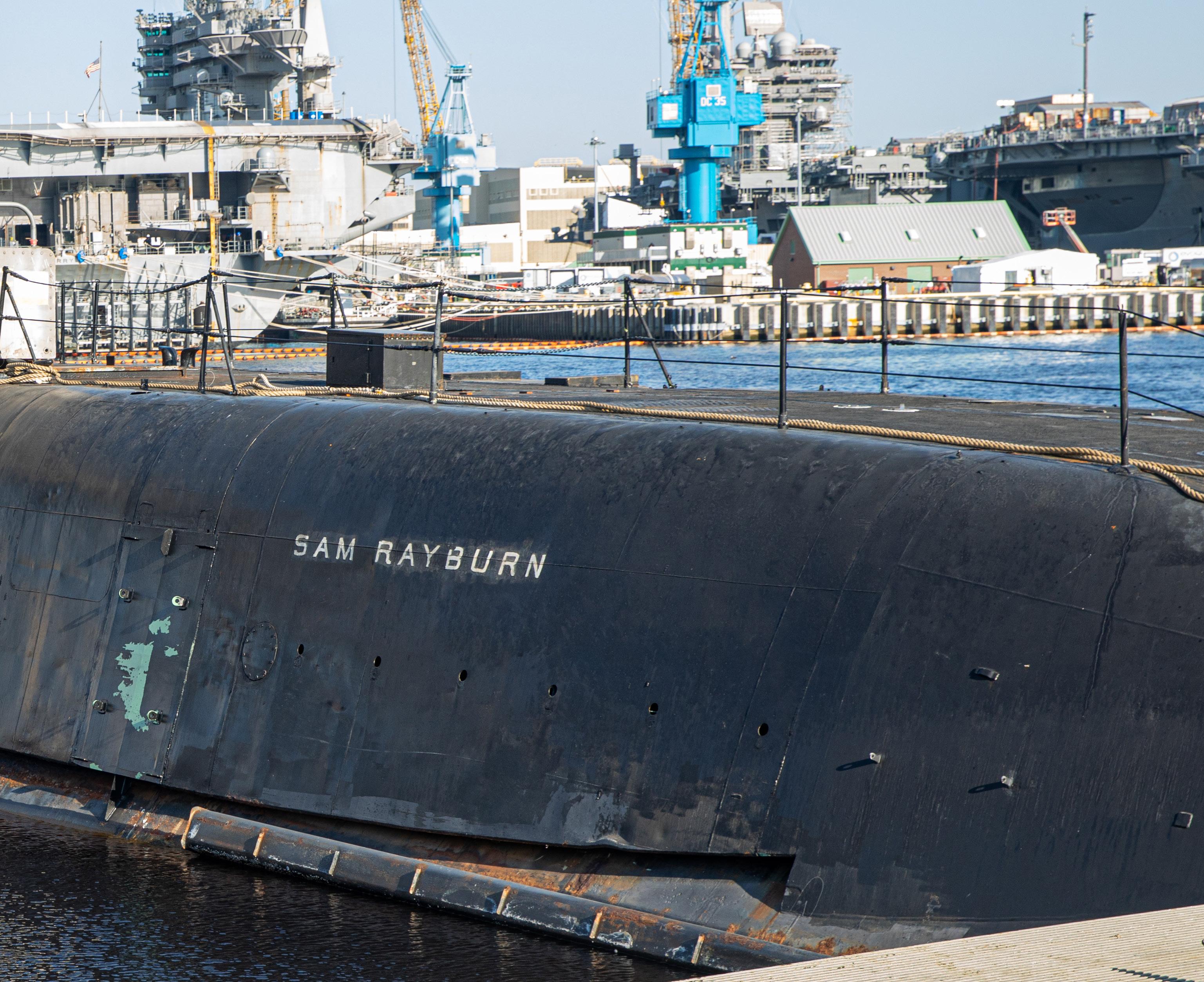
12 minute read
SIGHTLINES
Sight Line: The Commander's View, VADM William Galinis
In my last column, I talked about why our four naval shipyards are so important to our national defense. You maintain and modernize the types of warships that provide our Navy with an unquestionable advantage against our enemies – submarines and aircraft carriers. Now, I want to discuss how the Navy, NAVSEA, and your shipyard leadership are working to support you – the men and women charged with ensuring our submarines and carriers are fit to fight when called upon.
Advertisement
We are on a journey to re-capitalize and transform our Naval Shipyards. There are three key elements to this effort as outlined below – • Shipyard Infrastructure Optimization Program (SIOP) – This effort includes building a digital twin model of each shipyard to study and improve material and work flow through the shipyard. We will use that information to redesign the shipyards through infrastructure recapitalization efforts that will build / upgrade drydocks, improving the layout of the shipyards to maximize efficiencies – from where you park your car to where your worksite is located and your workstation is configured. We are also recapitalizing obsolete and maintenance-intensive equipment with modern equipment. The digital twins are expected to complete later, but we’re already moving out on some major programs. Drydock production work is underway at
PNSY and NNSY, with initial study, design and planning efforts underway for new drydocks at PHNSY & IMF and PSNS & IMF. The SIOP is a longer term effort currently planned to execute over the next 20 years. • Public Sector Improvement Plan (PSIP) – This effort focuses on assessing and planning shipyard workload over the next 15 years and transforming the way we plan and execute submarine and aircraft carrier availabilities. This effort uses data analytics through our Performance to Plan (P2P) effort to identify performance shortfalls and areas for improvement. The results of the P2P effort will allow us to shape and inform an effort specifically designed to support our waterfront personnel. The Naval Sustainment Systems – Shipyards (NSS-SY) will bring the most change to all four naval shipyards in the near term; with pilot projects and efforts currently being worked across all public shipyards to improve planning and execution performance. More on this particular effort below. • Information Technology (IT) Upgrades – The plan for this effort is in the early stages of development and ties in with a larger Navy effort to upgrade our IT infrastructure. Key elements of this effort includes replacing / upgrading many of our logistics and maintenance software applications. I’ll provide more information on this effort as we further mature the plan.
While all three efforts are vital to our long term ability to maintain and modernize our submarines and carriers, in the near term there is an urgent requirement to both execute the current maintenance workload, and improve our cost and schedule performance. A need to “Get Real” – understand our current levels of performance and factors contributing to delivering only 30% of our availabilities on time; and then to “Get Better” – improving our cost and schedule performance to deliver every ship on time, every time!
This is where the NSS-SY comes into play. NSS-SY is designed to improve productivity by identifying and removing barriers (administrative, material, technical, etc.) you face in doing your job. It is focused on ensuring our production workforce has what you need, when you need it, so you can do your job. Leveraging industry experience and recent successes within the Navy Aviation Enterprise, we are integrating industry and government best practices with the rigorous requirements tied to planning and executing submarine and aircraft carrier maintenance availabilities. With a bias toward action and a sense of urgency, NSS-SY focuses on ensuring the production workforce has the tools, equipment, material, and information needed to execute your work in an efficient manner while identifying and removing barriers that could delay work.
For our waterfront and shop trades and mechanics, our first and secondline supervisors - NSS-SY is focused on finding ways to minimize the amount of administrative and non-value-added work that consumes much of your day, so you can spend more time at the worksite addressing issues as they arise.
As I mentioned, there are pilot projects in progress in all four shipyards, so some of you may have already seen some NSS-SY efforts in action. For example, if you’ve been assigned to USS PASADENA (SSN 752) recently you may have seen that the project team implemented a daily production meeting structure that focuses on identifying issues and driving solutions to eliminate delays. Part of this effort is a new Zone Manager CRT Goal Tracker that sets milestones for the week and then tracks those efforts during daily production meetings. If roadblocks are identified, they will be either removed at the Zone Manager level or escalated up the chain of command until the impediment to the ontime completion is eliminated.
NSS-SY is a fast moving program, and we’re going to need your input. Ownership of these changes will be key to ensure enduring improvement. This effort has the backing of the entire Department of the Navy specifically to support you so we can deliver every submarine and aircraft carrier on time, every time.
VADM William Galinis Commander, Naval Sea Systems Command
USS Pasadena (SSN 752) arrived at Norfolk Naval Shipyard (NNSY) Sept. 28 for a Drydocking Selected Restricted Availability (DSRA).

NAVAL SUSTAINMENT SYSTEM - SHIPYARDS EFFORT NOW IN FULL SWING AT NORFOLK NAVAL SHIPYARD
STORY BY MICHAEL BRAYSHAW • LEAD PUBLIC AFFAIRS SPECIALIST PHOTO BY DANNY DEANGELIS • NNSY PHOTOGRAPHER
This article links to:
How do you improve the highly complex business of ship maintenance to support on-time delivery back to the Fleet?
It’s a tough nut to crack, and one that’s getting attention at the highest levels of Navy. Helping to conquer this challenge is the Naval Sustainment System – Shipyards (NSS-SY) effort across all four of the nation’s public shipyards in an aligned initiative with Naval Sea Systems Command (NAVSEA).
Centering on empowering project mechanics and driving continual work execution on the availability deckplates, NSS-SY is modeled on the successful effort at the Navy’s Fleet Readiness Centers (FRCs) to achieve more mission capable F/A-18 E/F Super Hornets and EA18G Growlers. Regardless of the product line being by air or sea, the same ingredients for success include having a sense of urgency, a willingness to challenge established modes of thinking, and ensuring quick and visible change where possible in matters of maintenance.
NSS-SY is part of an overarching effort at the four shipyards implementing the Navy’s Public Shipyard Improvement Plan. This plan aims to enhance production efficiency and schedule execution to shorten the duration of availabilities using both NSS-SY and Perform-to-Plan (P2P), a Navywide approach to combine continued learning and data-driven decisions to improve ship maintenance.
“Perform to Plan originated in aviation depot maintenance with resounding success,” said Commander Dave McGlone, NAVSEA 04 X Military Deputy. “While there are definite differences between aviation and ship depot maintenance, the overall concept is to make data-driven improvement decisions in our ship maintenance business. There’s a lot of emphasis on ship maintenance at the highest levels of our Navy and beyond, and there’s a high demand for increased operational ability. The shipyards have a huge role to play in this and it’s essential that each person recognize just how pivotal their contributions are to this tremendously important goal.”
Across the public shipyards, NSS-SY is a partnership of on-site contractors specializing in business processes, along with dedicated shipyard personnel who ensure Navy standards are met while collaborating to bring innovations to the deckplates. “We have worldclass performers and a lot of great intelligence and talent in our yards doing a lot of extremely complex maintenance,” said McGlone. “A fresh look through P2P is helping us identify where we can continue to improve our business in making our organization more efficient, delivering boats on time, and planning for shorter durations than we have today to meet that operational demand.”
Norfolk Naval Shipyard (NNSY) and Puget Sound Naval Shipyard and Intermediate Maintenance Facility (PSNS & IMF) were the first two shipyards, piloting the NSS-SY effort in August 2019. NNSY’s initial focus was identifying and mitigating any constraints to bolster performance of topside work on USS George H.W. Bush (CVN 77), including catapult systems and jet blast deflectors. One improvement included a topside temporary material storage area for NNSY’s Outside Machine Shop (Shop 38) onboard the carrier, providing greater accessibility and convenience for project mechanics. This aligned with the NSS-SY priority of ensuring tradespeople have the tools and equipment at the ready to execute work efficiently and with requisite first-time quality.
NSS-SY was relaunched in January 2021 with NNSY’s concentration on USS Pasadena (SSN 752), a Los-Angeles class submarine currently undergoing a Drydocking Selected Restricted Availability. Navy leaders such as Acting Secretary of the Navy Thomas Harker met with the Pasadena team in recent weeks to pledge their support and discuss the drive to “get real, get better,” encouraging shipyarders to candidly discuss any constraints so they can be resolved. “As you identify problems and barriers to success in your work, there are people across the enterprise asking how they can remove those problems now and for the future,” said Harker. “We’re looking across naval leadership at the things we can put in place to knock down those barriers.” NSS-SY improvements have included a new daily production meeting cadence, focusing on key issues and barrier removal. A new Horizon Review Board model has replaced the previous NAVSEA Project Support Meeting format, emphasizing the “get real, get better” concept and ensuring increased action and support from NAVSEA and corporate partners. Additionally, NNSY is getting “back to the basics” with the reimplementation of crew boards across the waterfront. “We are excited about all of the improvement occurring at each of the four shipyards and the potential this effort has for our corporation,” said NSS-SY Champion Amanda Gulledge. “We are challenging ourselves, our processes, and cutting through the red tape to embrace change, with full support and backing of NAVSEA leadership and the VCNO. That is powerful; this is our moment to turn ourselves into the top performing world class organization we know we can be.”
NSS-SY initiatives will work in tandem with the Shipyard Infrastructure Optimization Program (SIOP), a 20-year, $21 billion program dedicated to completely refurbishing the nation’s four public shipyards by modernizing equipment, improving workflow, and upgrading dry docks and facilities. Whereas SIOP will provide the physical upgrades to the shipyards, NSS-SY initiatives will provide the procedural updates to ships undergoing maintenance and modernization to maximize workforce productivity. “Efforts supporting the Navy’s Public Shipyard Improvement Plan are very important to us at America’s Shipyard,” said Shipyard Commander Captain Dianna Wolfson. “The plan is greatly aligned to messages we’ve been receiving from Navy leadership to ‘get real, get better’ in our service to the Fleet with an intent to either ‘fix or elevate’ problems in our work. Ensuring a sense of urgency and resolve at all levels of the workforce, working in conjunction with our contracting partner on this effort, will help us reach our vision of delivering on time, every time, everywhere, to protect America.”
Dependable Mission Delivery
NNSY WELCOMES MTS SAM RAYBURN FOR INACTIVATION

STORY BY MICHAEL BRAYSHAW • LEAD PUBLIC AFFAIRS SPECIALIST PHOTO BY DANNY DEANGELIS • NNSY PHOTOGRAPHER
Norfolk Naval Shipyard (NNSY) welcomed the Moored Training Ship Sam Rayburn (MTS 635) in advance of its inactivation April 3.
Rayburn (formerly SSBN-635) served as a MTS at Nuclear Power Training Unit—Charleston for more than 30 years training Sailors in the operation, maintenance and supervision of nuclear propulsion systems. Along with MTS Daniel Webster (MTS 626), Rayburn is being replaced by the next-generation training vessels MTS La Jolla (MTS 701) and USS San Francisco (SSN 711).
Providing unique opportunity for the NNSY workforce, Rayburn marks the Navy’s first inactivation of a MTS. Upon completion of this work, Rayburn will be towed to Puget Sound Naval Shipyard for recycling. NNSY will also perform Webster’s inactivation.
“USS Sam Rayburn has proudly served the U.S. Submarine Force and Navy Nuclear Propulsion Program since 1964, and we now welcome it to America’s Shipyard,” said Shipyard Commander Captain Dianna Wolfson. “Performing the first inactivation of a Moored Training Ship will develop another important facet in our service to the Fleet, and we look forward to excelling in our mission as one team.”
Throughout Rayburn’s three-decade stint as a training vessel, NNSY has performed maintenance on it as needed, sometimes in Portsmouth when a dry docking was required, and other times onsite in Charleston, sending upwards of 200 employees to perform Pierside Extended Maintenance Availabilities and support depot level repairs during continuous maintenance availabilities.
Commending Norfolk Naval Shipyard’s Charleston (NNSY-CHS) team for its record of planned maintenance and emergent repairs, Admiral James Caldwell, Director, Naval Reactors, said, “NNSYCHS’s efforts directly contributed to the Naval Nuclear Propulsion Training Program’s (NNPTP) ability to meet or exceed annual fleet requirements for qualified operators for the past several years, allowing the nuclear Navy to achieve 100 percent fleet manning for the first time in ten years. This recognition speaks to the direct leadership, dedication and follow through of a passionate team striving for consistent impactful results.”
During this time of modernization for the NNPTP, the NNSYCHS team has been concurrently working retirements of Rayburn and Webster; delivering and supporting work of the new vessels; and

modernizing the site to enhance future training needs.
“Preparing and towing the MTS 635 represents the next step in modernizing the nuclear training program here in Charleston,” said MTS Project Superintendent Chrystal Brady. “By retiring the MTS 635, NPTU Charleston can move forward with the final preparations to receive the MTS 711 later this year. The NNSY Charleston team continues to demonstrate dedication to the mission of the site! To care for and deliver this asset, many personal sacrifices have been made over the years to deliver on maintenance schedules and, most recently, to ensure an on-time tow. Our team takes great pride in the way we represent NNSY and the Navy every day!”
Exemplifying Captain Wolfson’s “One Mission-One Team” mantra, sending Rayburn to Portsmouth required constant communication and coordination between NNSY and its Charleston team hundreds of miles away. “There were several key parts to this plan for Norfolk Naval Shipyard—the safe departure from Charleston, tow, and safe arrival at Norfolk Naval Shipyard,” said Pat Ensley, NNSY Submarine Program Manager. “This was a great team effort to accomplish this mission. The detailed preparations for departure took significant planning and execution to complete the preparations for tow.”
Following La Jolla which completed its conversion at NNSY in November 2019, San Francisco is now in the final stages of becoming a Moored Training Ship for towing to Charleston. These conversions are the closest NNSY has come to new ship construction since the 1950s, requiring two complete hull cuts, separating each boat into three pieces, recycling the center section, and adding three new hull sections, adding 76 feet to the overall length on both vessels.










